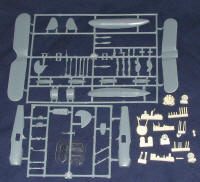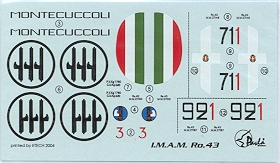
| KIT: | Octopus 1/72 IMAM Ro.43 |
| KIT #: | 72053 |
| PRICE: | $33.98 (29.96 at Squadron) |
| DECALS: | Three options |
| REVIEWER: | Scott Van Aken |
| NOTES: | Short run with resin and vacuformed parts |

| HISTORY |
During 1935-36, there became a need for a shipboard fighter and reconnaissance aircraft. Since Italy had no aircraft carrier, this meant a floatplane. Developed from the older Ro.37bis, IMAM came up with the Ro.44 for a fighter and the Ro.43 for the reconnaissance aircraft. Both of them were quite similar aside from the design of the fuselage. Power was provided by a Piaggio P.X R nine-cylinder air cooled radial developing 670 hp for take off. This was enough to push the Ro.43 through the air at a maximum speed of 186 mph at altitude. Normal cruise was a more sedate 112 mph. Defensive armament was a single 7.7mm gun on a flexible mount in the rear while the pilot had a fixed forward firing gun of the same calibre.
The most aircraft available was in late 1939 when 105 were on hand with another 29 undergoing construction. When Italy entered the war in 1940, over half of the 101 extant airframes were either in storage or undergoing some sort or repair/overhaul. These aircraft were designed to be carried aboard ship for gun fire spotting and other general duties. Most ships carried one while some battleships had three. The aircraft was designed with folding wings so that they could be more easily stored.
Typical of Italian aircraft designed before the war, it was under-powered, under-armed and strange for a floatplane, it had poor rough water handling capabilities (which meant that everything got wet). Yet it carried on throughout the war, 28 aircraft still being extant in September 1943 when the Italian capitulated, though most were unserviceable.
| THE KIT |
 If
you have had the chance to read the
preview of the Ro.44, then you'll spot a lot of similarities between
that and this kit. It is understandable as much of the airframe is the
same. In fact, one entire sprue is identical as are most of the resin
parts. The different sprue carries the fuselage, new fin and the two place
interior bits. The resin is for the engine, a lot of little interior bits,
some small struts, exhaust, and wheels for the beaching dolly. It also
includes a resin prop hub. I do wish that these folks would do a fully
formed prop as attaching single plastic blades to an open hub is a real
pain. I'd actually prefer either a full resin prop or a nicely done cast
metal one. A well done vacuform sheet is in somewhat thicker than normal
plastic which is fine with me as it provides a larger gluing surface. I do
wish, however, that a duplicate was provided as getting replacement bits
for short run kits can be problematic.
If
you have had the chance to read the
preview of the Ro.44, then you'll spot a lot of similarities between
that and this kit. It is understandable as much of the airframe is the
same. In fact, one entire sprue is identical as are most of the resin
parts. The different sprue carries the fuselage, new fin and the two place
interior bits. The resin is for the engine, a lot of little interior bits,
some small struts, exhaust, and wheels for the beaching dolly. It also
includes a resin prop hub. I do wish that these folks would do a fully
formed prop as attaching single plastic blades to an open hub is a real
pain. I'd actually prefer either a full resin prop or a nicely done cast
metal one. A well done vacuform sheet is in somewhat thicker than normal
plastic which is fine with me as it provides a larger gluing surface. I do
wish, however, that a duplicate was provided as getting replacement bits
for short run kits can be problematic.
The plastic is well molded with fine engraved panel lines. The canvas is well done without the usual 'hills and valleys' that one often sees with fabric covered aircraft. I saw no sink areas and the only ejector towers are inside some of the larger parts. These are easily removed with a pair for flush sprue cutters, leaving just some minor clean up. There is also some flash, but those of us who build kits like this realize that we have to clean up every single part so that just comes with the territory.
Octopus instructions are among the
better ones done. This 12 page booklet includes a short history, a parts
guide, color guild with FS 595, Humbrol, Agama, and generic names. The 19
step construction sequence takes us to the mid section of the booklet. Strangely missing is any sort of rigging
diagram. I know that single-bay biplanes are among the easiest to do, but
the box art only provides profiles so a diagram would be helpful.
the mid section of the booklet. Strangely missing is any sort of rigging
diagram. I know that single-bay biplanes are among the easiest to do, but
the box art only provides profiles so a diagram would be helpful.
Markings are for three aircraft, all with black lower float surfaces. Two are in silver, including the smaller profile on the box from a cruiser. This aircraft is in prewar markings and has large red stripes on the upper wing to be painted on. The other is from 1942 and is in olive green uppers and light grey lower surfaces. The one not shown is from the battleship 'Vittorio Veneto' and is in silver with a white fuselage band. The rudder on this one is dark green. Decals are very well printed and should provide no problems.
| CONCLUSIONS |
Once again, Octopus has given us an interesting aircraft. One sees few Italian floatplanes done up and this one will make into a most interesting model when it is finished. Though I'd not recommend it for beginners, if you have a few modern short run kits under your belt, this one should be no real problem.
April 2005
| REFERENCES |
Warplanes of the Second World War; Floatplanes. Volume 6. William Green, 1962
You can find this kit and many others at

If you would like your product reviewed fairly and quickly by a site that has nearly 300,000 visitors a month, please contact me or see other details in the Note to Contributors.